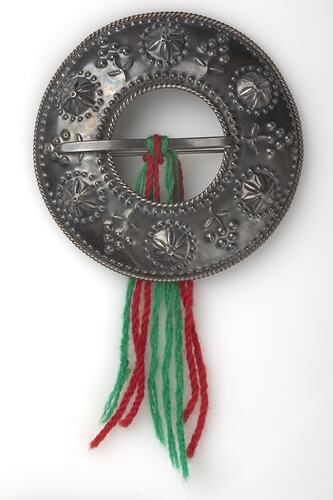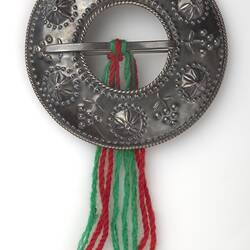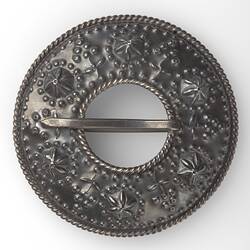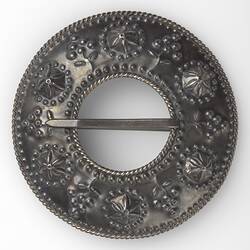Summary
Set of three metal brooches made by Igors Polikevics and worn as part of a Nica region Latvian costume. The brooches are attached to the right hand shoulder holding the shawl in place. Igors migrated to Australia at the age of 9 in 1949, following World War Two.
The brooches belonged to Anita Apinis, daughter of Latvian migrant and weaver Anna Apinis. Anita is second generation Latvian weaver, she was taught by her mother Anna and then undertook further training at the Melbourne College of Textiles. Anita's parents, Anna and Ervins, migrated to Australia in 1950, after spending time in a displaced persons camp Memmingin in Germany following World War Two. Anna had learnt to weave in Latvia and continued weaving in Australia, becoming one of the few suppliers of Latvian national costumes in the 1950s and 1960s. Anna kept many of her cultural traditions alive by passing them onto Anita.
Physical Description
Three metal brooches in descending size order and identical design. Round with inner round hole, and a metal pin welded across the hole. A metal pin is attached at the back of each brooch for attaching to garment. The brooches have a series of relief patterns, round stars and studs with a rope border around the outer and inner edges.
Significance
These items form part of the Apinis Latvian weaving collection, a collection of Latvian weavings, tools (including a countermarch floor loom), weaving notebooks, costume items and audio visual interviews. Its historical and cultural significance lies in the comprehensive documentation of the story through artefacts and narratives, the quality of the weavings and the rarity of particular items such as the loom created in a German displaced persons' camp after World War II and notebooks kept from the 1930s to preseve traditional Latvian weaving techniques. The collection documents the maintenance and transportation of cultural traditions.
More Information
-
Collecting Areas
-
Acquisition Information
Donation from Ms Anita Apinis-Herman, 02 Feb 2011
-
Maker
-
User
-
Other Association (See Comments)
Nica, Latvia
Worn as part of a costume based on designs from this region -
Classification
Cultural identity, Ethnicity - cultural practices, Jewellery
-
Category
-
Discipline
-
Type of item
-
Overall Dimensions
110 mm (Width), 110 mm (Height), 110 mm (Outside Diameter)
-
Overall Dimensions
80 mm (Width), 80 mm (Height), 80 mm (Outside Diameter)
-
Overall Dimensions
65 mm (Width), 65 mm (Height), 65 mm (Outside Diameter)
-
References
Apinis-Herman, Anita, "Latvian Weaving Techniques", Kangaroo Press, 1993 Page 68 : how the brooch is attached to the shawl, across the the right hand side of the of the shoulder. See also image 42 page 68. These notes were provided by Anita Apinis-Herman at the time of donation.
-
Keywords
Clothing Accessories, Cultural Identity, Displaced Persons, Handcrafts, Immigration, Latvian Communities, Latvian Immigration, Metalcraft, Refugees, Displaced Persons Camps





